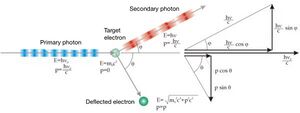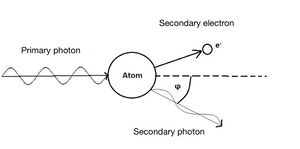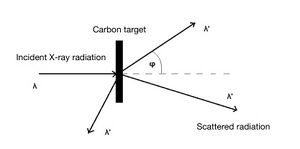Compton scattering
Compton scattering describes the collision of a photon with, for example, an electron due to subsequent changes in the wavelength of the resulting photon.
History[edit | edit source]
In 1905, Albert Einstein introduced the idea of the corpuscular wave character of particles to explain the photoelectric effect . Since, according to her, it was possible to consider a photon to be both a wave and a particle, there should be interactions between it and, for example, an electron, which would correspond in nature to elastic collisions, during which total momentum and energy are conserved within the isolated system.
However, according to the ideas of classical physics, after the collision of a photon with an electron, the electron should be oscillated by the frequency of the incident photon and then send out photons again with the same frequency.
In 1922, Arthur Holly Compton decided to test this theory . He created an X-ray scattering experiment on free electrons. It was necessary to use the impact of radiation on materials with very weakly bound electrons. X-rays (λ = 0.07 nm) hit the carbon target. Compton was able to detect duplicate spectral lines : one corresponded to the original wavelength (scattering on tightly bound electrons), the other had a higher wavelength (scattering on free electrons). The correctness of Einstein's theory was thus experimentally confirmed, and Compton won the Nobel Prize in Physics in 1927 .
Compton shift[edit | edit source]
The existence of a second wavelength was expressed by the equation for the Compton shift:
λ ... the wavelength of the photon before the collision
λ´ … the wavelength of the photon after the collision
φ … scattering angle
h/m 0 c ... Compton wavelength (for an electron = 2.4262 · 10-12 m)
Additions to the theory[edit | edit source]
In theory, the Compton effect occurs every time a photon collides with an electron, but if the mass of the photon is very small compared to the mass of the electron, this shift is minimal. Because of this, the Compton effect can only be observed using radiation with a high photon mass, such as X-rays or gamma rays.
The secondary photon deviates in the interval 0–180° and its energy depends on the deviation. If there is backscattering (i.e. 180° angle), the photon has the least energy. The secondary photon may be able to repeat the phenomenon again if it has sufficient energy, or it decays through the photoelectric effect.
Use[edit | edit source]
The Compton effect is used in many scientific fields. Examples include radiotherapy (targeted DNA damage of e.g. cancer cells), spectroscopy (detection of ionizing radiation) and astronomy (Compton's gamma observatory).
Links[edit | edit source]
Related articles[edit | edit source]
- Compton's phenomenon - what it proves and benefits
- Photoelectric phenomenon
- Electron-positron pairs
- Gamma radiation
References[edit | edit source]
- NAVRÁTIL, Leoš. Medicínská biofyzika. 1. edition. Praha : Grada, 2005. 524 pp. pp. 351-352. ISBN 80-247-1152-4.
- BENEŠ, Jiří. Základy lékařské biofyziky. 1. edition. Praha : Karolinum, 2007. 202 pp. pp. 183-184. ISBN 978-80-246-1386-4.





